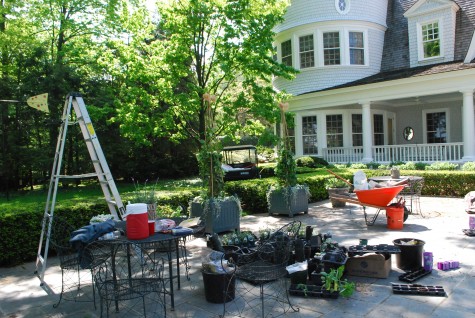Planting containers is a big job, especially when there are lots of them. I plant almost 40 containers for this client every year; I plant 27 pots of my own at home every year. Every year I have to fight off the urge to plant more pots. That said, I have a few ideas about how to keep the project manageable-both in design and execution. Every bill I send is completely detailed as to plant varieties and numbers. Feel free to try this at home. Keep track of how many plants it takes to plant your containers. Take pictures. Keep notes about what you like-and do not like. This helps keep the shopping part organized. I know ther numbers of plants this job requires; I plan ahead. This is essential, as she lives 45 minutes away from the shop.
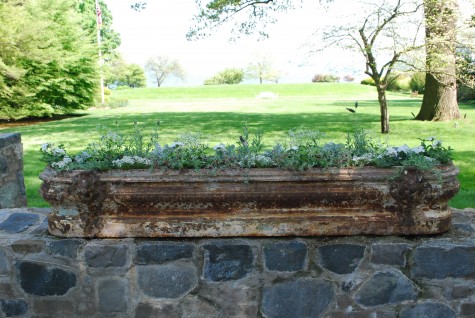 Round containers-think of them as needing layers of plants-planted in rings. A centerpiece plant is ringed by a mid layer ring, and an edge ring. Bigger pots need more rings-smaller ones need fewer. This long rectangular planter needs 2 long rows of plants. When I lay out the planter, I start in the center, and work to each side, so the planting is symmetrical. This planter, just like a window box, only has so many spaces for plants. I pick my palette, and then figure out how many repeats I will need. The repetition of plants establishes a visual rhythm. In contemporary plantings, I may plant just one plant all over, and hope that plant has a favorable season.
Round containers-think of them as needing layers of plants-planted in rings. A centerpiece plant is ringed by a mid layer ring, and an edge ring. Bigger pots need more rings-smaller ones need fewer. This long rectangular planter needs 2 long rows of plants. When I lay out the planter, I start in the center, and work to each side, so the planting is symmetrical. This planter, just like a window box, only has so many spaces for plants. I pick my palette, and then figure out how many repeats I will need. The repetition of plants establishes a visual rhythm. In contemporary plantings, I may plant just one plant all over, and hope that plant has a favorable season.
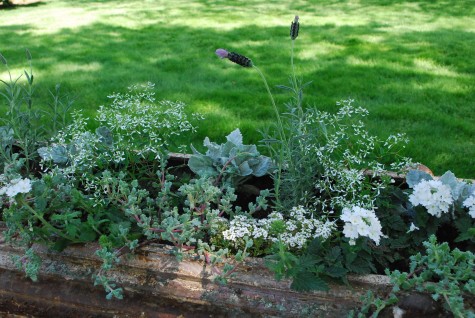 Once I have some numbers in mind, I think about what plants make good neighbors-both side to side, and front to back. My diamond frost euphorbia asks for something with a denser texture and bigger flower-does it not? Verbena is a great companion plant. Cirrus dusty miller has big, matte, felted leaves. A good companion? The tiny and angular leaved shiny succulent pictured above provides good contrast in form and texture, while repeating that grey-blue color. A good companion to lavender, whose flowers and foliage are so wispy, is alyssum, which flowers low, and profusely.
Once I have some numbers in mind, I think about what plants make good neighbors-both side to side, and front to back. My diamond frost euphorbia asks for something with a denser texture and bigger flower-does it not? Verbena is a great companion plant. Cirrus dusty miller has big, matte, felted leaves. A good companion? The tiny and angular leaved shiny succulent pictured above provides good contrast in form and texture, while repeating that grey-blue color. A good companion to lavender, whose flowers and foliage are so wispy, is alyssum, which flowers low, and profusely.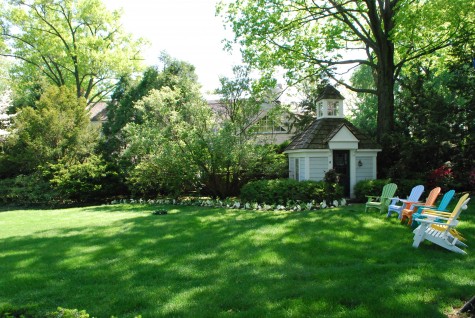 It is hard to see what is going on in this annual bed far from the terrace-but for the blobs of white. That white is from the leaves of caladiums-they read well from a distance. Later in the season, short white and tall lime green nicotiana will bloom. The ground cover under all-white polka dot plant. This shade planting is a much more interesting solution than white impatiens. Lime green coleus would look great here as well. This is a collection of plants that work well together. Larger growing plants means you do not need so many to make a statement. Space your plants in the ground knowing how they will mature. In-ground plantings spaced too close together not only invites disease, it can result in an overall shape that is not distinctively shapely.
It is hard to see what is going on in this annual bed far from the terrace-but for the blobs of white. That white is from the leaves of caladiums-they read well from a distance. Later in the season, short white and tall lime green nicotiana will bloom. The ground cover under all-white polka dot plant. This shade planting is a much more interesting solution than white impatiens. Lime green coleus would look great here as well. This is a collection of plants that work well together. Larger growing plants means you do not need so many to make a statement. Space your plants in the ground knowing how they will mature. In-ground plantings spaced too close together not only invites disease, it can result in an overall shape that is not distinctively shapely.
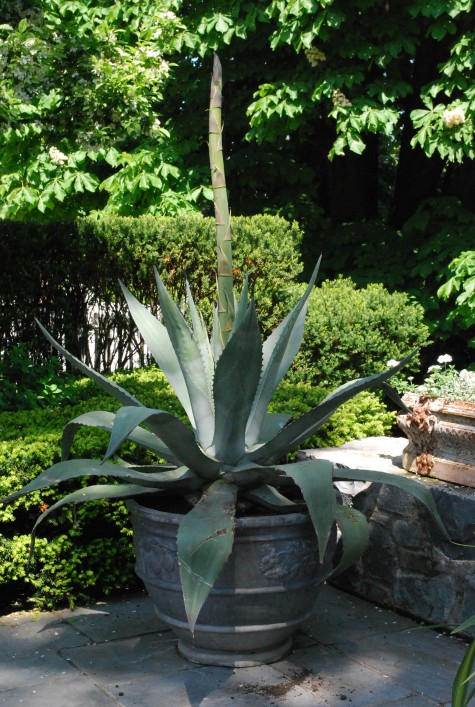 This old agave-this is its final year. Agaves need to be quite old before they bloom. Once they bloom, the parent plant dies, leaves the baby offshoots to continue. This bloom stalk could grow to 14 feet or better. This agave is part of a collection of plants my client has had for a number of years. We underplanted it with a mass of Kent Beauty oregano, a soft, drapy, and delicately colored ornamental oregano that will highlight the visual architecture of the agave by way of considerable contrast in scale, texture and form.
This old agave-this is its final year. Agaves need to be quite old before they bloom. Once they bloom, the parent plant dies, leaves the baby offshoots to continue. This bloom stalk could grow to 14 feet or better. This agave is part of a collection of plants my client has had for a number of years. We underplanted it with a mass of Kent Beauty oregano, a soft, drapy, and delicately colored ornamental oregano that will highlight the visual architecture of the agave by way of considerable contrast in scale, texture and form.
 Phormiums, or New Zealand flax have an architectural presence on a smaller scale. The diamond frost euphorbia will froth up and spill over the container. This is a collection of two that looks handsome together.
Phormiums, or New Zealand flax have an architectural presence on a smaller scale. The diamond frost euphorbia will froth up and spill over the container. This is a collection of two that looks handsome together.
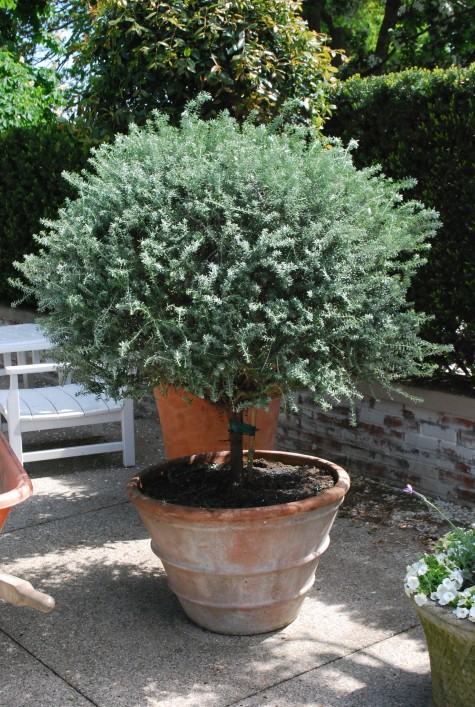 Another member of the topiary plant collection, a Teucrium Fruticans on standard. Bush germander has silver needled leaves, and grows 4 to 6 feet tall in warmer climates. This topiary has to be wintered in a barely heated light space. Any collection of plants that can be wintered over in a light space or garage has two advantages. They not only live a much longer life than most annuals, they grow and become sizeable. This germander is almost 10 years old; it is a beautiful container plant indeed.
Another member of the topiary plant collection, a Teucrium Fruticans on standard. Bush germander has silver needled leaves, and grows 4 to 6 feet tall in warmer climates. This topiary has to be wintered in a barely heated light space. Any collection of plants that can be wintered over in a light space or garage has two advantages. They not only live a much longer life than most annuals, they grow and become sizeable. This germander is almost 10 years old; it is a beautiful container plant indeed.
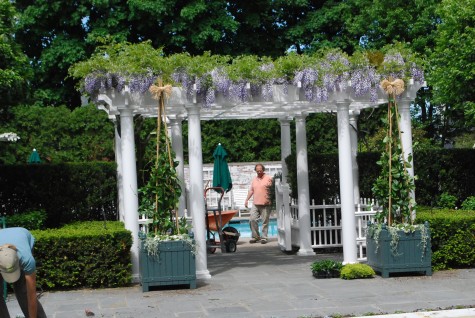 We planted white mandevillea, and staked it on four 10′ natural bamboo poles. We secure the poles with concrete wire for strength, and covered the wire with simple raffia bows. Lime nicotiana, white angelonia, silver dichondra, white anyssum and white million bells rounds out the collection.
We planted white mandevillea, and staked it on four 10′ natural bamboo poles. We secure the poles with concrete wire for strength, and covered the wire with simple raffia bows. Lime nicotiana, white angelonia, silver dichondra, white anyssum and white million bells rounds out the collection.
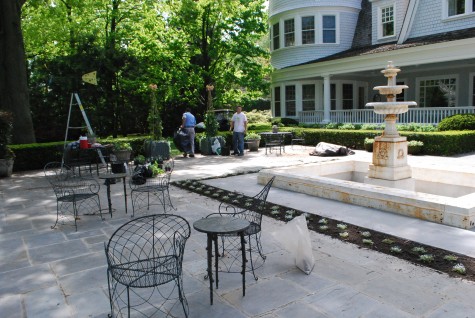 The newly created plant frame around the fountain is planted with Isotoma Fluviatilis. I spaced the plants at a foot apart, as it grounds very quickly. Hardy to minus 20 degrees, and tolerant of heavy foot traffic, it will barely break the plane of the stone. The new stone around the fountain is angled slightly away from the fountain, so rain will not pool there. The plant frame helps to minimize that stone set on a slightly higher grade than the original terrace.
The newly created plant frame around the fountain is planted with Isotoma Fluviatilis. I spaced the plants at a foot apart, as it grounds very quickly. Hardy to minus 20 degrees, and tolerant of heavy foot traffic, it will barely break the plane of the stone. The new stone around the fountain is angled slightly away from the fountain, so rain will not pool there. The plant frame helps to minimize that stone set on a slightly higher grade than the original terrace.
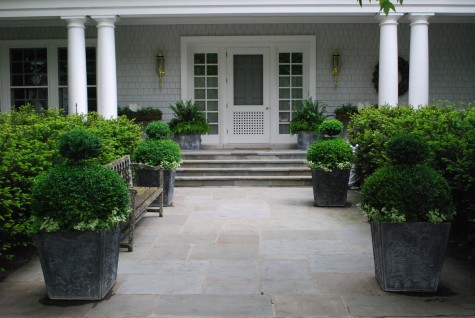 Four lead pots sit on the front walk, each with its own boxwood topiary. These boxwood are hardy in my zone 7 out of every 10 years, so I winter them in an unheated dark space for the winter-just to be sure. The ball shaped boxwood with attending topknots is a good contrast to the tapered shape of the lead pots. Variegated licorice at the corners, with a green dichondra in between completes the planting.
Four lead pots sit on the front walk, each with its own boxwood topiary. These boxwood are hardy in my zone 7 out of every 10 years, so I winter them in an unheated dark space for the winter-just to be sure. The ball shaped boxwood with attending topknots is a good contrast to the tapered shape of the lead pots. Variegated licorice at the corners, with a green dichondra in between completes the planting.
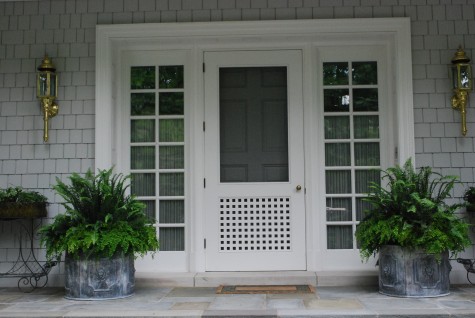
A lovely pair of Kimberly ferns flank the front door. As they tend to grow upright in a vase shape, I planted maidenhair ferns as a groundcover under the Kimberlys. This puts the overall edges of the planting gracefully out over the edges of the round lead pots. I do so love pots planted green.
